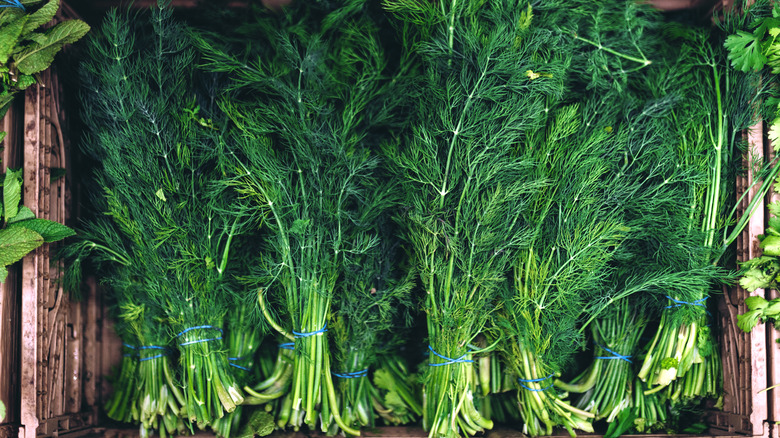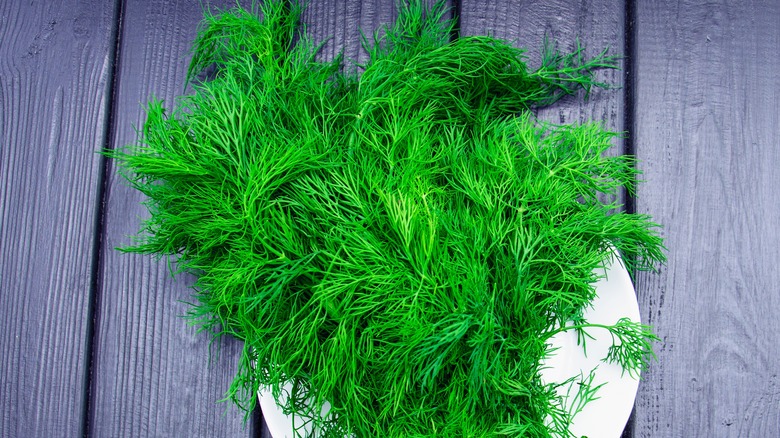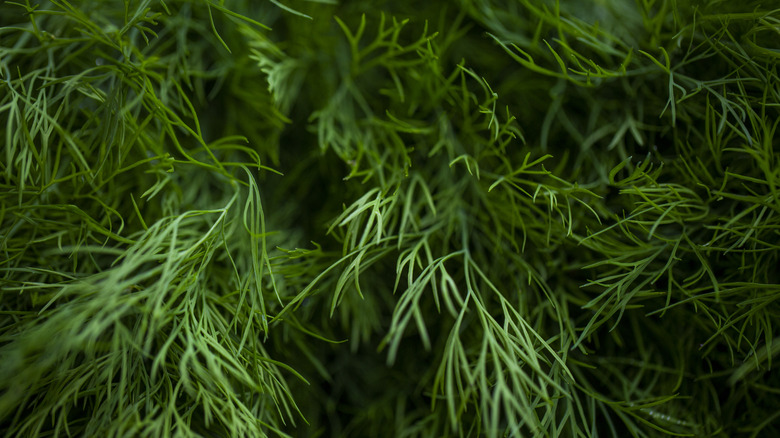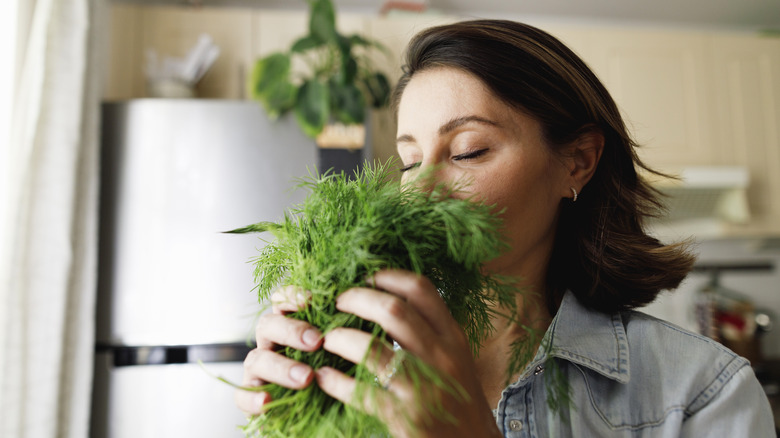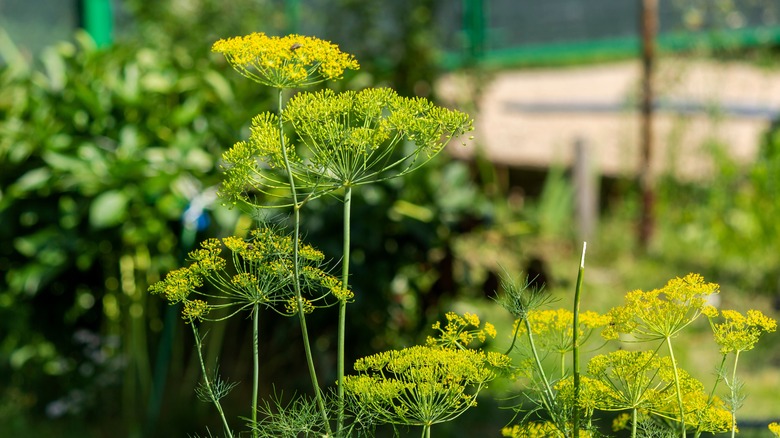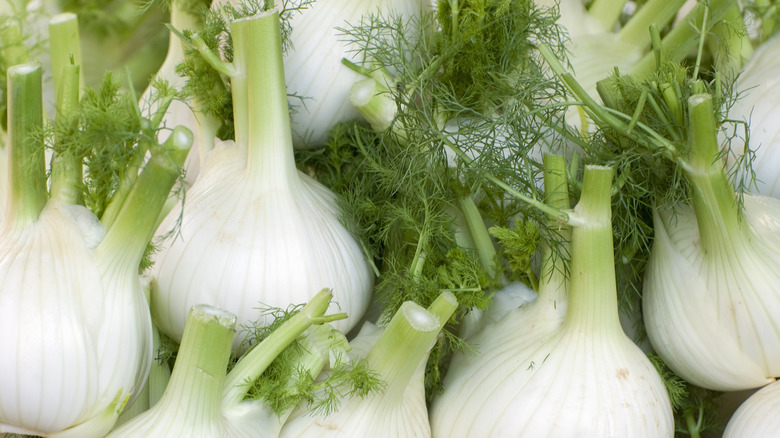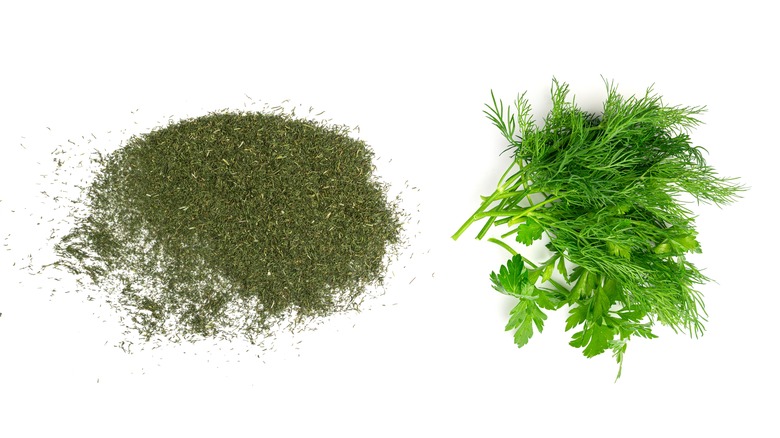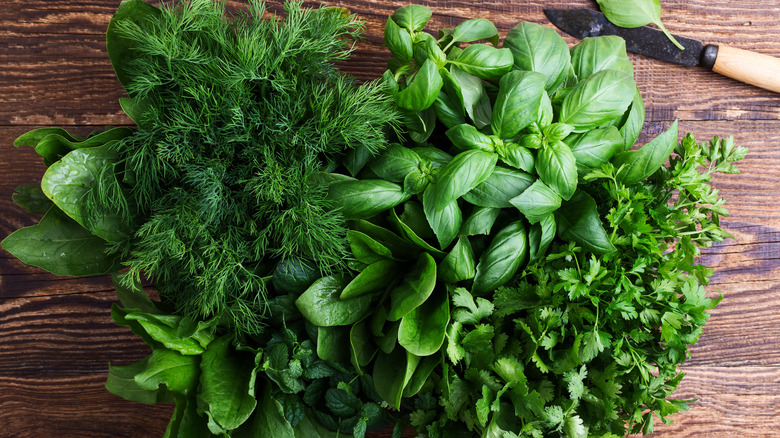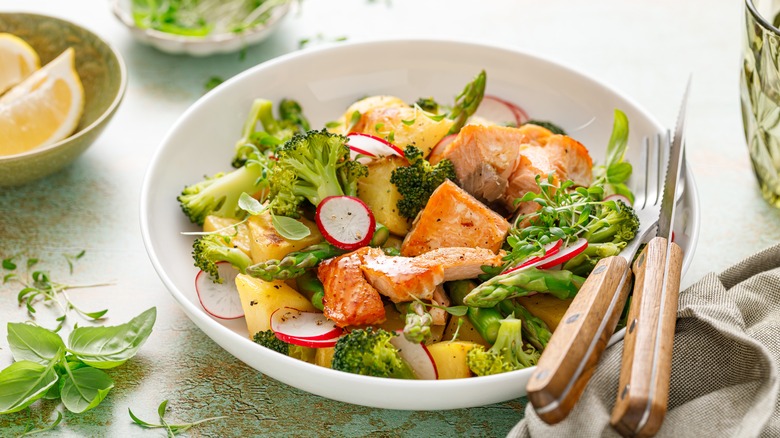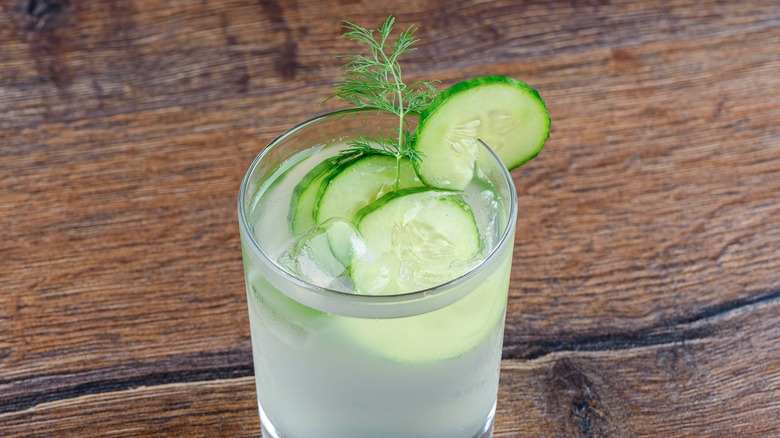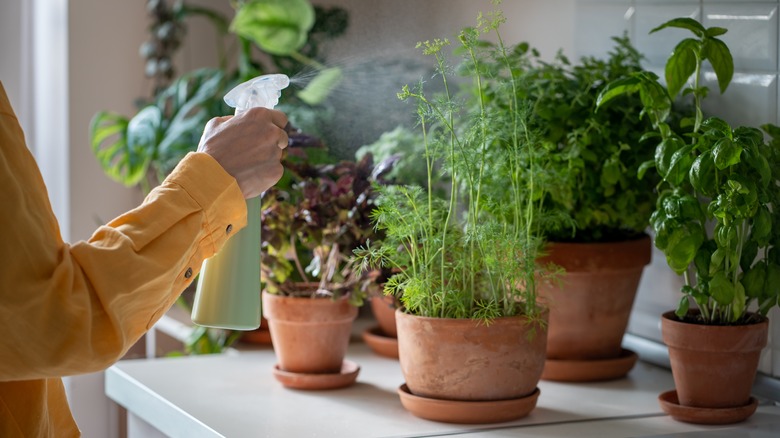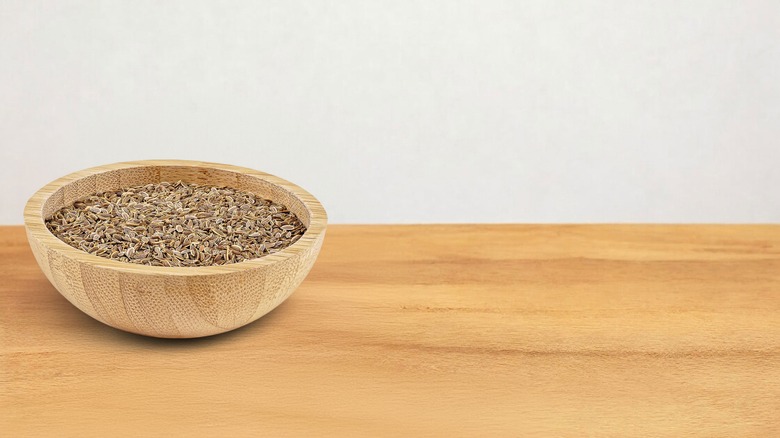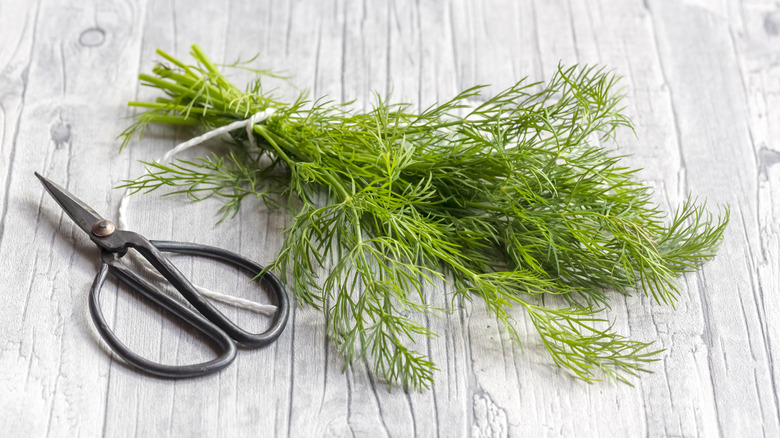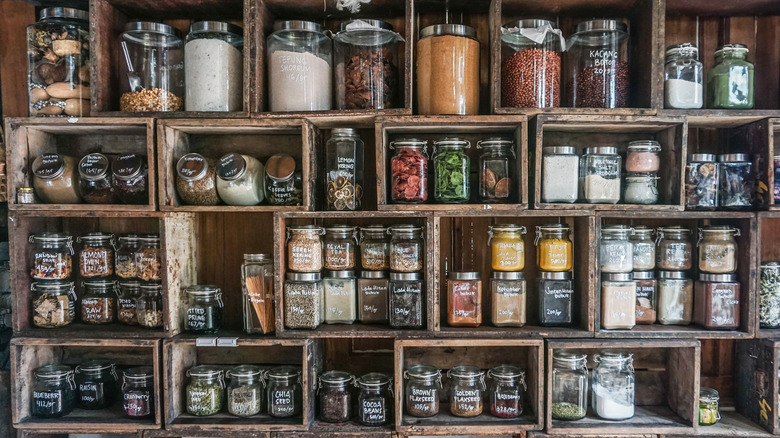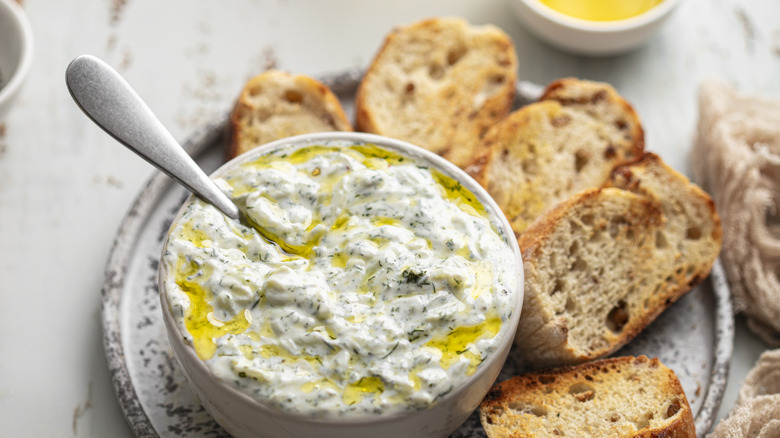Everything You Ever Needed To Know About Dill
Everybody loves dill. Its hallowed role in pickles, potato salad, pasta salad, sauces, and dips has been well-established in American cuisine. However, it gets too little recognition for the bright flavor it can also bring to soups, stews, breads, and cheeses. Let's just say there's more to know about this herb, beloved the world over for thousands of years.
The first main thing to understand about dill is that there exist numerous forms of it available to the home cook. If you haven't explored it fresh, dried, and seeded, then you're missing out. The second main characteristic that many people miss about dill is how incredibly versatile it is. While it is mostly confined to savory foods, it isn't exclusively. (Eyeballing you, cocktails.) Also, though it is commonly associated with lighter spring and summer foods, such as salads, it's equally good in fall and winter dishes.
In other words, you need to know more, so dill is totally worth the deep-dive treatment it's about to get. Your kitchen and spice rack will be better for it, and so will your meals all year round.
What is dill?
Dill (Anethum graveolens) is a classic herb used in cooking. It is a member of the carrot family, related to celery, parsley, and yes, carrots. It is relatively unique in that one plant produces both seeds and fresh herbs, much like cilantro (whose seed is known as coriander). Dill is a soft, bright green plant with feathery leaves and loose yellow flowers in summertime. It grows easily in gardens and volunteers year after year if you let it go to seed.
While "dill weed" has become a hilarious insult more than a culinary name over the last several decades (more power to those who are still using this OG term of non-endearment), it actually represents proper terminology: not a synonym, but an official part of the dill plant. Dill weed refers to the leafy greens you use fresh or dried, as compared to dill seed, which is collected once the plant flowers and dries.
Dill history 101
Dill has a long history in cooking and medicine, stemming from Ancient Greece, Egypt, and Babylon. It also has a place in mythology and folk medicine. Dill's place in the ancient world is attested to by its presence throughout many cultures and the fact that it still played a major role in charms in medieval times.
A good 5,000 years ago, the herb had a reputation in Egypt as being soothing, whereas in Greece, its oil was burned to scent homes and it was used in making wine. Called "meetinghouse seeds," dill was chewed in church to stay alert during long services, according to some sources. Others claim that brides from Germany and Belgium would conceal dill on themselves on their wedding days, helping to ensure happiness. Grooms might also put the seeds in their pockets. It's unclear when these traditions ended, so perhaps they are ongoing in some parts of Europe. Feel free to carry them on if you like; Chowhound won't judge.
Throughout history, many people have cultivated dill. The Babylonians had it in their gardens, for instance, and medieval Europeans' penchant for it clearly proves how widespread it was by modern times. Today, you'll find dill in many a garden (including this writer's).
The flavor of dill
Dill's flavor is fresh and citrusy, with a hint of grassiness. This latter taste means it can become overpowering if you use it too liberally, but it is perfect for brightening up dishes that are otherwise rather plain or heavy ... hence its classic use in soups and potato salads.
The flavor of dill is comparable in some ways to that of licorice, fennel, and tarragon, but more subtle, with less of that overpowering taste. As such, it is capable of imparting those subtle licorice flavors without the smothering of other ingredients that the other herbs can create if used too liberally. Do note that you must get dill at the right time of year, however. After the plant bolts (flowers), the leafy fronds get bitter and unappealing for use in the kitchen.
Dill seeds have their own flavor. While they have the same hints of licorice and citrus, they are also nutty, with additional flavors of mint and bitterness. Some folks compare the flavor to that of caraway, which is why they're typically used in stronger dishes, such as pickling or meats.
Common varieties of dill
Dill comes in various varieties, some of which are better suited to certain dishes than others. Where possible, match the types of dill you use to their preparation. Some are good for pickling, others for salads. You can also base your variety on the size of the plant or how long it survives in the garden before bolting. (As for buying it in-store, most bottled spices don't distinguish as to variety, so this is mainly a note for gardeners.)
Dill varieties may be cultivated for one of two basic properties: giving good seeds, or lasting a long time before bolting, the better to provide leafy green herbs later into the season. The Bouquet variety is known for producing lots of good seeds for pickling. Some adherents also like Mammoth and Long Island varieties for seeds, pointing out that these cultivars are often responsible for the dill seed you'll find in the store. Beware, though, that Mammoth is an enthusiastic sower of seeds, so if you don't want annual dill patches in your garden, you must harvest seed heads assiduously.
For container gardening, where space is at a premium, try Fernleaf or Teddy, which are both compact but full. Dukat is also good for containers, while Delikat grows very densely, so if you love fresh dill in your cooking, opt for that. If you're looking for a plant that will last long into the year and you don't particularly care about seeds, Vierling is a great choice.
Dill versus fennel
Fennel is another member of the carrot family. You can see its family relationship to dill in the form of its feathery fronds, which are delicate and airy the same way dill's are. Fennel also bears an open, yellow flower like dill, so they can be hard to tell apart in the garden unless you know what you're looking at. Moreover, it has the same licorice or anise flavor profile.
Their kinship and similarities might tempt you to believe that fennel and dill are interchangeable, but that's not the case. Fennel does not contain the same citrusy, minty, bright flavor that dill does, rather tending toward the licorice-only side of the spectrum. That said, if you really don't have dill and need something fresh, you can substitute fennel leaves in a 1:1 ratio with dill. Just use a light hand.
Trying to tell them apart? The most distinguishing characteristic of fennel is its big white bulb, which develops above the ground as it grows. If you're not sure which is which (as has actually happened to this writer when getting mysterious summer produce through a farm share), you can chew some of the fronds.
Available forms of dill
Most stores sell dried dill weed in a jar. Look with the other jarred spices, and try to select dill weed that is still a nice, green color. Dill that has turned greyish, brownish, or a dark pine hue is not as fresh as that which is still a deep and vibrant green. Check the expiration date as well. While dried herbs don't typically go bad in the sense that they can harm you, they are certainly tastier within their specified windows.
Many also sell dill seeds and fresh dill. You'll find the former in the same place as you would the dried dill weed, typically in a jar. However, you might also find seeds in a small vial or plastic bag (the kind with the cardboard informational tag stapled on). Fresh dill is with the other fresh greens, typically near the lettuce, kale, spinach, and herbs. If you can't find what you're looking for at your local grocery, go to a specialty shop. If you're still frustrated, you can shop for a vast array of dried dill products online.
How to choose the best herbs at the store
If you can, always choose fresh herbs for your cooking. They have the brightest and best taste, especially for dishes that rely on other fresh ingredients, such as dips or salads. You can get away with dried dill better in soups, stews, potatoes, and other hearty preparations.
If you are buying fresh, look for bundles that stand straight when held, are bright green, and smell like themselves (no fishy or old vegetal aromas, please). If you see anything slimy or off-color, avoid and buy a dried product instead. Alternatively, you can use a substitute herb. Fennel is a decent option, as discussed, but you can also use parsley, chervil, basil, rosemary, thyme, or tarragon.
Look for dried dill and dill seeds that are within their best-by date, as this will lead to more flavor. You should also look for products that were produced locally if you can. Unlike wine, saffron, or fancy cheese, there's no reason your dill seeds would need to come from overseas, and local options are likelier to be fresh because they don't have to travel as far.
Common uses for dill in the kitchen
Dill is hugely versatile in the kitchen, ideal for freshening up a wide variety of foods. You can put it in soups and stews, rice dishes, herbed potato salads, and more. This author's favorite way to use dill is one she learned from her mother and involves steaming and then heavily buttering carrots before liberally sprinkling them with salt and dried dill. The flavor combo of carrots and dill, both from the same plant family, is seriously unbeatable (by anything that isn't cake). This dish goes great with Thanksgiving turkey ... you will not be able to stop eating them.
If you want to get experimental, try it in shrimp salad toast Skagen, a popular Swedish appetizer confusingly named after a Danish town. It combines some of the best things in life, including creamy shrimp salad, buttery toast, roe (fish eggs), and, of course, dill. Seafood and dill are, in fact, a match made in heaven. You'll also find it in shrimp scampi, salmon rub, and deviled eggs with shrimp. It is also a critical ingredient in homemade lox (and if you've ever made homemade lox, you know it's absolutely worth learning how).
Other recipes for dill include pickled veggies, such as beets and asparagus, as well as cucumbers. Pickled eggs are also a fun use for dill, as are pasta and egg salads, both of which can use the same basic mayo-salt-dill flavor profile of a good potato salad.
Cocktail hour with dill
Drinks with dill? Actually, yes, this herb is excellent in a variety of cocktails due to its bright and citrusy flavor. While we no longer dose people with dill for bravery (as they did with gladiators in Ancient Rome), there's nothing wrong with adding a sprig or a sprinkle to a cocktail for a little of that liquid courage.
Dill pairs well with lime (citrus on citrus always being a good idea), as well as both vodka and gin, so it's the perfect option for a summer drink. Try a dill cucumber gin fizz or a cucumber dill martini for a hint of fresh pickle flavor that will take your next cocktail hour to Gatsby levels. Make sure to save some of the feathery fronds at the ends, which are the prettiest and most delicate, to garnish your drinks. You can also arrange it on drinks trays for Instagram-worthy visual appeal.
Growing your own dill plants
Dill is a happy and relatively undemanding annual as long as it gets enough water, growing in summer in USDA zones 2-8. It may grow as a perennial in zones 9 and above; just note that, as with many plants that are annuals in colder climates, other climatic factors may influence how readily it grows as a perennial. It is easy to harvest, dry, and store, so it's a perfect culinary plant for gardeners who don't have a ton of time to dedicate to the hobby.
A true sunshine lover, dill prefers open spaces where it will get full sun (defined as six or more hours per day, though dill will happily take dawn-to-dusk exposure). It likes well-drained soil and moderate water, so don't let it dry out completely. It does not care for wind, so make sure you plant your dill in a protected location if you live somewhere gusty, such as the beach. Seeds are difficult to transplant, so plan to sow them directly outdoors as soon as the seed packet says to.
Note that as soon as it gets hot, most dill varieties will bolt, so harvest whatever greens you want before summer truly sets in. If you're going for seeds, of course, this isn't a problem. You can expect blooms from August through September for most dill plants, though depending on the variety, this can happen earlier or later.
The preparation of and uses for dill seeds
Dill seeds are a popular use of the plant as well. Like the leaves, they can be used in soups and sauces, as well as veggies and meat dishes. They are commonly added whole to pickle brines, and may in general be used whole or ground using a mortar and pestle. However, because they're relatively delicate, most recipes just call for them as-is.
If you grow dill in your garden, you can gather dill seeds yourself. All you have to do is allow the dill to bolt, which means letting it flower and then go to seed. (If you remove the flower head, the plant will not produce seeds, so you'll have to live through that ugly dying-brown-flower stage, sorry.) Once seeds have appeared, you can remove the flowers and bundle them, then hang them upside down somewhere dry at room temperature. When the flower heads have desiccated completely, you can shake seeds into a box or bag, then remove extraneous plant material and store them.
Health benefits of dill
The nutrient profile of dill is great news. It contains high levels of vitamin C, vitamin A, manganese, folate, and iron. Its antioxidant properties mean it can help protect your cells against the destructive effects of molecules known as free radicals. These chemical compounds arise from pollution, medications, and objects in our everyday environment. Free radicals also develop in the body as a result of radiation and can cause cancer and a raft of other illnesses: autoimmune diseases, arthritis, neurological conditions, and more.
As such, keeping dill in your life is a good idea. It may also benefit heart health, boost your immune system, and protect you against cancer. What's not to like? You can get the benefits of dill from both fresh dill weed and seeds. Because leaves and seeds have different concentrations of chemical compounds, it's a good idea to mix their use in your cooking; the better to nab all those health benefits.
Storing dill to last
How you store dill will depend on what form it is in. If you're storing dried herbs, try to keep the jar in a cool, dry place out of direct sunlight. The biggest danger to dried herbs, including both dill weed and dill seeds, is that they will get damp. Exposure to sunlight also damages the flavor and freshness of dried herbs because it causes the flavor compounds to break down. While it won't make them dangerous, it will limit their ability to brighten and enhance your food.
Fresh herbs are easily stored standing up in a glass of water, either in the fridge or on the counter (the former will make them last longer, though). Tender herbs like dill, which are easily crushed, are best stored this way. To do this, rinse the herbs and dry them gently, trim off the bottom inch of stems, and put them in a glass of water, bouquet-style. Put them in the fridge, where they will last for up to two weeks.
You can also freeze dill. To do this, arrange the fronds on a cookie sheet in a single layer, freeze them, and then put them in a glass jar in the freezer, where they'll last for a year. You can also chop them and put them in ice cube trays, then cover them with oil or water and freeze. Once frozen, store them in a plastic bag or a freezer jar.
Nutritional information
Dill is low-calorie. Indeed, five springs of dill contain less than a calorie, so you can happily add it to your clean eating regimen. Given its lack of unsaturated fat and cholesterol, any home cook should feel free to use a liberal hand when dill-ing various dishes, whether you're using fresh stems, dried herbs, or seeds. If you're using it in the amounts called for in most recipes (e.g., chopped leaves stirred into a potato salad or seeds added to a jar of pickles), then you're completely safe to use it unless you are allergic.
However, do note that in rare cases consuming dill can lead to GI distress or an allergic reaction. Also, while dill's health benefits are well-attested, you should never use medicinal preparations of any herb without consulting a healthcare provider. Research on its effects in large amounts is limited, so pregnant women should talk to their obstetricians before using it for any purpose other than culinary.
